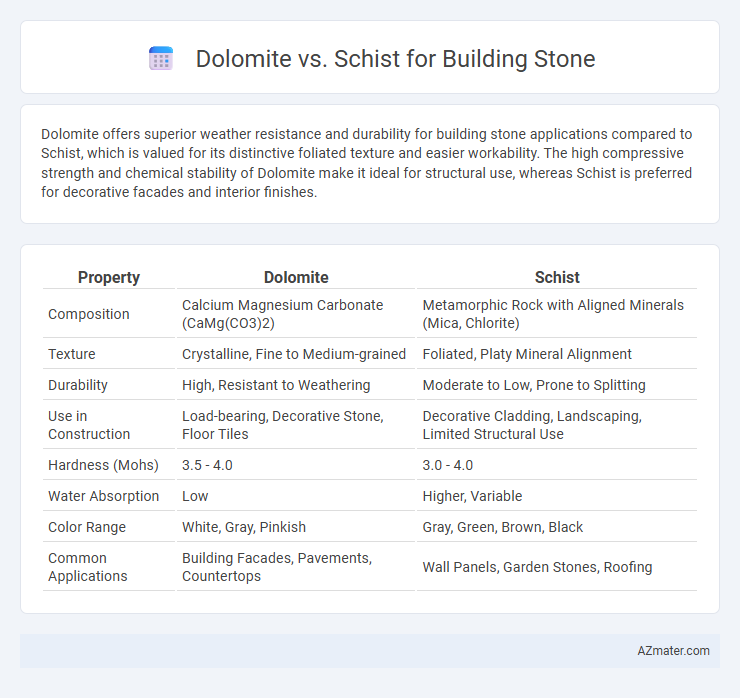Dolomite offers superior weather resistance and durability for building stone applications compared to Schist, which is valued for its distinctive foliated texture and easier workability. The high compressive strength and chemical stability of Dolomite make it ideal for structural use, whereas Schist is preferred for decorative facades and interior finishes.
Table of Comparison
| Property | Dolomite | Schist |
|---|---|---|
| Composition | Calcium Magnesium Carbonate (CaMg(CO3)2) | Metamorphic Rock with Aligned Minerals (Mica, Chlorite) |
| Texture | Crystalline, Fine to Medium-grained | Foliated, Platy Mineral Alignment |
| Durability | High, Resistant to Weathering | Moderate to Low, Prone to Splitting |
| Use in Construction | Load-bearing, Decorative Stone, Floor Tiles | Decorative Cladding, Landscaping, Limited Structural Use |
| Hardness (Mohs) | 3.5 - 4.0 | 3.0 - 4.0 |
| Water Absorption | Low | Higher, Variable |
| Color Range | White, Gray, Pinkish | Gray, Green, Brown, Black |
| Common Applications | Building Facades, Pavements, Countertops | Wall Panels, Garden Stones, Roofing |
Overview: Dolomite vs Schist as Building Stones
Dolomite, a carbonate mineral composed primarily of calcium magnesium carbonate, offers high durability and resistance to weathering, making it suitable for structural applications and exterior cladding. Schist, a metamorphic rock characterized by its foliated texture and mineral alignment, provides aesthetic appeal with its varied mineral content but generally exhibits lower strength compared to dolomite. Both materials are valued in construction; dolomite excels in load-bearing contexts while schist is preferred for decorative and interior uses.
Geological Formation and Composition
Dolomite, a sedimentary carbonate rock primarily composed of the mineral dolomite (CaMg(CO3)2), forms through the diagenetic alteration of limestone, often in shallow marine environments rich in magnesium. Schist, a metamorphic rock characterized by its foliated texture and abundant mica minerals, develops under medium- to high-grade regional metamorphism of sedimentary or igneous precursors. The compositional differences highlight dolomite's chemical uniformity and schist's mineralogical diversity, influencing their suitability and durability as building stones.
Physical Properties Comparison
Dolomite exhibits higher hardness with a Mohs scale rating of about 3.5 to 4, compared to schist's generally lower hardness of 2 to 4, making dolomite more resistant to abrasion and suitable for structural applications. The density of dolomite ranges from 2.85 to 2.95 g/cm3, offering greater weight-bearing capacity, while schist varies widely between 2.7 and 3.0 g/cm3 depending on its mineral composition and foliation. Dolomite's granular texture and uniform composition result in lower porosity and superior weathering resistance, whereas schist's foliated structure causes anisotropy and variable durability under load and environmental exposure.
Durability and Weather Resistance
Dolomite offers superior durability and weather resistance compared to schist, making it a preferred choice for building stone in harsh climates. Its crystalline structure provides excellent resistance to erosion, chemical weathering, and freeze-thaw cycles. Schist, while aesthetically appealing with its foliated texture, tends to be more porous and prone to splitting, which reduces its longevity and weather resistance in structural applications.
Structural Strength and Load-Bearing Capacity
Dolomite exhibits higher structural strength and superior load-bearing capacity compared to schist due to its dense, crystalline structure and lower porosity. Schist, characterized by its foliated texture and pronounced cleavage planes, tends to have lower compressive strength and may be susceptible to shear failure under heavy loads. For construction projects requiring robust, durable foundation or load-bearing elements, dolomite is generally preferred over schist for enhanced stability and longevity.
Workability and Cutting Ease
Dolomite offers superior workability and cutting ease compared to schist due to its uniform crystalline structure and moderate hardness, allowing precise shaping with less effort and tool wear. Schist's foliated texture presents challenges in cutting, as its layered composition can cause uneven breakage and increased tool resistance. Builders often prefer dolomite for detailed stonework where smooth finishes and accuracy are critical, while schist is better suited for rustic applications where natural textures are desired.
Aesthetic Appeal and Color Variations
Dolomite exhibits a subtle, often creamy to light gray color palette with a smooth, crystalline texture that enhances architectural elegance. Schist offers a broader spectrum of colors including greens, grays, and purples, with its foliated structure providing unique, natural patterns ideal for decorative facades. The choice between dolomite and schist depends on desired visual impact, with dolomite's uniformity favored for sleek designs and schist's variegated appearance suited for dynamic, textured aesthetics.
Environmental Impact and Sustainability
Dolomite offers better durability and lower porosity compared to schist, resulting in less water absorption and reduced weathering, which contributes to longer-lasting structures and decreased maintenance needs. Schist's foliated nature can lead to higher susceptibility to erosion and structural weakening, increasing the frequency of repairs and material consumption over time. The extraction of dolomite generally has a smaller environmental footprint due to more efficient quarrying processes, while schist quarrying often causes greater landscape disruption and higher energy consumption, impacting overall sustainability in building applications.
Cost and Availability in Construction
Dolomite is generally more affordable and widely available in many regions, making it a cost-efficient choice for construction projects requiring durable building stone. Schist tends to be more expensive due to its limited availability and complex extraction process, which increases transportation and material costs. The abundant supply of dolomite simplifies procurement and reduces overall construction expenses compared to the relatively scarce and costly schist.
Best Applications: Choosing Dolomite or Schist
Dolomite offers high durability and resistance to weathering, making it ideal for structural foundations, exterior cladding, and paving in both residential and commercial construction. Schist, characterized by its foliated texture and aesthetic appeal, excels in decorative applications like wall veneers, landscaping features, and interior flooring where visual impact is prioritized. Selecting between Dolomite and Schist depends on balancing structural strength needs with design preferences, ensuring optimal performance and appearance in building projects.

Infographic: Dolomite vs Schist for Building Stone
 azmater.com
azmater.com